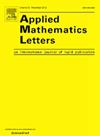A comparative study of dynamic models for gravity-driven particle-laden flows
IF 2.9
2区 数学
Q1 MATHEMATICS, APPLIED
引用次数: 0
Abstract
The dynamics of viscous thin-film particle-laden flows down inclined surfaces are commonly modeled with one of two approaches: a diffusive flux model or a suspension balance model. The diffusive flux model assumes that the particles migrate via a diffusive flux induced by gradients in both the particle concentration and the effective suspension viscosity. The suspension balance model introduces non-Newtonian bulk stress with shear-induced normal stresses, the gradients of which cause particle migration. Both models have appeared in the literature of particle-laden flow with virtually no comparison between the two models. For particle-laden viscous flow on an incline, in a thin-film geometry, one can use lubrication theory to derive a compact dynamic model in the form of a 2 × 2 system of conservation laws. We can then directly compare the two theories side by side by looking at similarities and differences in the flux functions for the conservation laws, and in exact and numerical simulations of the equations. We compare the flux profiles over a range of parameters, showing fairly good agreement between the models, with the biggest difference involving the behavior at the free surface. We also consider less dense suspensions at lower inclination angles where the dynamics involve two shock waves that can be clearly measured in experiments. In this context the solutions differ by no more than about 10%, suggesting that either model could be used for this configuration.
重力驱动颗粒流动力学模型的比较研究
粘性薄膜颗粒沿倾斜表面向下流动的动力学通常用两种方法中的一种来建模:扩散通量模型或悬浮平衡模型。扩散通量模型假设颗粒通过由颗粒浓度和有效悬浮粘度梯度引起的扩散通量迁移。悬浮平衡模型引入了非牛顿体应力和剪切法向应力,其梯度引起颗粒迁移。这两种模型都出现在载重颗粒流的文献中,实际上没有两种模型之间的比较。在薄膜几何条件下,对于倾斜上的含颗粒粘性流动,可以利用润滑理论推导出2 × 2守恒律系统的紧致动力学模型。然后,我们可以通过观察守恒定律的通量函数的异同,以及方程的精确和数值模拟,直接比较这两种理论。我们比较了一系列参数下的通量分布,显示了模型之间相当好的一致性,最大的差异涉及自由表面的行为。我们还考虑了在较低倾角下密度较小的悬架,其中动力学涉及两个激波,可以在实验中清楚地测量。在这种情况下,解决方案的差异不超过10%,这表明任何一种模型都可以用于此配置。
本文章由计算机程序翻译,如有差异,请以英文原文为准。
求助全文
约1分钟内获得全文
求助全文
来源期刊

Applied Mathematics Letters
数学-应用数学
CiteScore
7.70
自引率
5.40%
发文量
347
审稿时长
10 days
期刊介绍:
The purpose of Applied Mathematics Letters is to provide a means of rapid publication for important but brief applied mathematical papers. The brief descriptions of any work involving a novel application or utilization of mathematics, or a development in the methodology of applied mathematics is a potential contribution for this journal. This journal''s focus is on applied mathematics topics based on differential equations and linear algebra. Priority will be given to submissions that are likely to appeal to a wide audience.
 求助内容:
求助内容: 应助结果提醒方式:
应助结果提醒方式:


